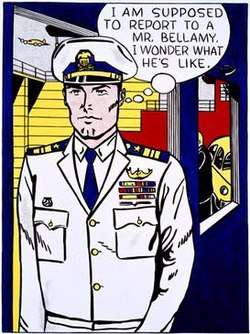Mr. Bellamy
Mr. Bellamy is a 1961 pop art painting by Roy Lichtenstein in his comic book style of using Ben-Day dots and a text balloon. The work is regarded as one of the better examples of Lichtenstein's sense of humor. The work is held in the collection at the Modern Art Museum of Fort Worth.[1]
| Mr. Bellamy | |
|---|---|
 | |
| Artist | Roy Lichtenstein |
| Year | 1961 |
| Movement | Pop art |
| Dimensions | 143.5 cm × 108 cm (56.5 in × 42.5 in) |
| Location | Modern Art Museum of Fort Worth |
Background
In 1961, Lichtenstein had developed the technique of emulating the mechanized production techniques, while simultaneously depicting the subjects of pop culture. This extended his pop art to a second dimension. He did so by developing a technique that took Ben-Day dots from small comic book panels and magazine pages to the grand scale of his oversized paintings.[2]
Lichtenstein was a trained United States Army pilot, draftsman and artist as well as a World War II (WWII) veteran who never saw active combat.[3][4] His list of aeronautical themed works is extensive. Mr. Bellamy depicts an air force soldier, according to some sources.[5] However, other sources claim that the subject is a military officer of unknown branch of service.[6] Created in Lichtenstein's breakthrough year, Mr. Bellamy represents an art world inside joke, which was succeeded the following year by a satirical statement on his own career the following year with Masterpiece.[7] In the work, Lichtenstein presents a wholesome male protagonist heading to an important meeting with a "Mr. Bellamy", who shared a name with one of Lichtenstein's important art world contacts, Richard "Dick" Bellamy, Green Gallery art dealer and director, who was known for presenting new work by unknown artists who had never been shown before.[2][8] The text balloon says "I am supposed to report to a Mr. Bellamy. I wonder what he's like."[9]
In November 1961, Lichtenstein sent Mr. Bellamy to Leo Castelli for sale.[10]
Critical response
The work represents Lichtenstein's "gentle, professorial humor" and his penchant for "corny themes, colors, and postures."[9] Apart from enlarging its size, Lichtenstein presented a "mere copy, lacking artistic originality and creativity" in this work.[6] This subject matter sourced from comic books was regarded as "the lowest commercial and intellectual kind" because of public sentiment on the heels of 1950s United States Senate investigations of connections between comics and juvenile delinquency.[6]
See also
Notes
- "Lichtensteins in Museums". LichtensteinFoundation.org. Archived from the original on June 6, 2013. Retrieved June 22, 2013.
- Shanes, p. 87
- "Chronology". Roy Lichtenstein Foundation. Archived from the original on June 6, 2013. Retrieved June 9, 2013.
- McCarthy, David (2004). H.C. Westermann at War: Art and Manhood in Cold War America. University of Delaware Press. p. 71. ISBN 087413871X.
- Pisano, Dominick A., ed. (2003). The Airplane in American Culture. University of Michigan Press. p. 275. ISBN 0472068334.
- Thistlethwaite, Mark. "Mr. Bellamy". Modern Art Museum of Fort Worth. Retrieved July 15, 2013.
- Shanes, p. 38
- Hendrickson, Janis (1994). Roy Lichtenstein. Benedikt Taschen. p. 20. ISBN 3-8228-9633-0.
- Madoff, Steven Henry, ed. (1997). Pop Art: A Critical History. University of California Press. p. 183. ISBN 0-520-21018-2.
- Rondeau, James and Sheena Wagstaff. Roy Lichtenstein: A Retrospective. Art Institute of Chicago. p. 346. ISBN 978-0-300-17971-2.
References
- Shanes, Eric (2009). Pop Art. Parkstone Press. ISBN 1844846199.